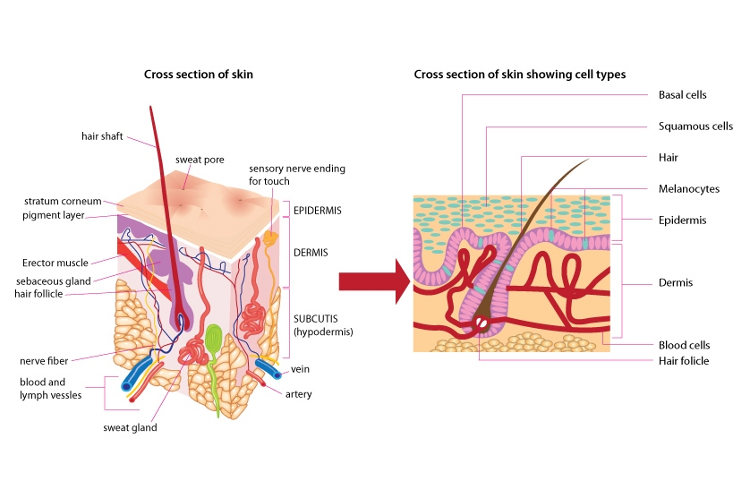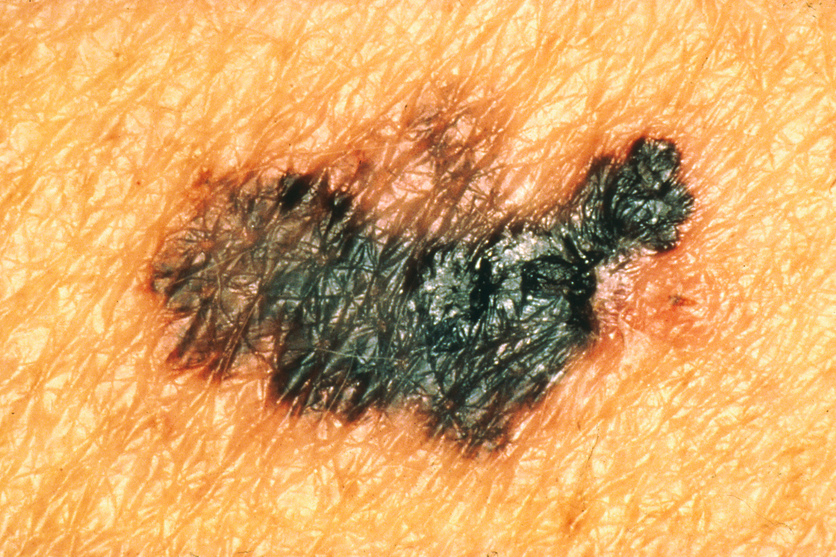Research shows a clear link between UV and skin cancer.
The skin of an average adult has a total surface of about 1.8 square metres and a total weight of about 11 kilograms. This makes our skin our largest organ – and certainly an organ that we should look after!
Skin has several important functions including acting like a shield to protect our body from:
- physical impact such as pressure and blows
- temperature impact such as heat or cold
- environmental impact such as the Sun’s UV radiation, bacteria and chemicals.
Skin cancer (carcinoma) is the uncontrolled division and growth of abnormal skin cells. Your skin has two main layers and several kinds of cells. The top, or outer, layer of your skin is called the epidermis. Skin cancers are classified by the type of epidermal skin cells that become cancerous.
Nature of Science
Scientists often use diagrams that are labelled to communicate detailed information. Scientists in a particular area will have a common understanding of these diagrams and the scientific language used.
Types of skin cancer
There are three common types of skin cancer:
- Basal cell carcinoma develops from abnormal growth of the basal cells – the round cells in the lowest layer of the epidermis.
- Squamous cell carcinoma develops in the flat scaly cells called squamous cells – found in the middle of the epidermis.
- Malignant melanoma occurs in the cells called melanocytes – responsible for producing the pigment melanin, which gives your skin its colour.
Which is the worst kind of skin cancer?
- Basal cell carcinoma is the most common and the least dangerous skin cancer. If it isn’t removed, it will be disfiguring, but it is not likely to metastasise (spread to other parts of the body).
- Squamous cell carcinoma is easily treated if it is found early enough but can be fatal if left untreated. Melanoma is the least common but the most deadly form of cancer.
- Melanoma does metastasise and spread to other organs, where it can grow rapidly and affect the ability of that organ to function properly. There is no effective treatment for melanoma that has metastasised to distant organs. It is generally incurable.
What causes skin cancer?
Research has shown that these skin cancers generally develop because of over-exposure to UV radiation (from the Sun or from sunlamps or tanning beds). Each time your unprotected skin is exposed to UV, the UV causes changes to take place in the structure of the genes and in the behaviour of the cells.
Normally, cells grow and multiply in an orderly way. However, damaged genes can cause cells to behave abnormally. These abnormal cells may grow into a lump (a tumour). These tumours will either be benign (not cancerous) or malignant (cancerous). Benign tumours can grow, but they do not spread to other parts of the body (metastasise).
At first, a malignant tumour will stay confined to its original site. (This is called carcinoma in situ.) However, if the cells are not treated quickly, they may spread into surrounding tissue and to other parts of the body. (This is called malignant or invasive cancer.) When these cancer cells reach another part of the body, they may continue to grow and form another tumour. This is called a secondary cancer (or a metastasis).
How is skin cancer treated?
Different types of cancer require different kinds of treatment. These include:
- surgical removal (the most common treatment)
- chemotherapy
- radiation therapy
- immunotherapy
- hormone therapy.
Once a cancer has developed, the outlook depends on a number of factors, including the type of cancer and how quickly it is diagnosed and treated.
Related content
These related articles explain why New Zealand skin cancer rates are so high, some of the risk factors and how skin cancer is diagnosed and treated.
Activity idea
For those interested in protection from UV, see The face of melanoma – an activity that looks at lifestyle factors that contribute to skin cancer.
Useful links
The SunSmart website is designed for students, teachers, schools and parents. It has information about UV, shade, hats, sunscreen, skin cancer and sun protection, as well as cross-curricula resources for teachers in the SunSmart Schools section.
The Cancer Society of New Zealand is the leading organisation dedicated to reducing the incidence of cancer and ensuring the best cancer care for everyone in New Zealand.
Melanoma New Zealand is a charity dedicated to preventing avoidable deaths and suffering from melanoma.
This Skin Cancer Foundation web page looks at skin types and at risk groups.
This HealthMatch article, Top 20 skin cancer hot spots in the world and why they're on the list, explores the roles that personal, cultural, and global habits play in rates of skin cancer and what we can do to change them.



